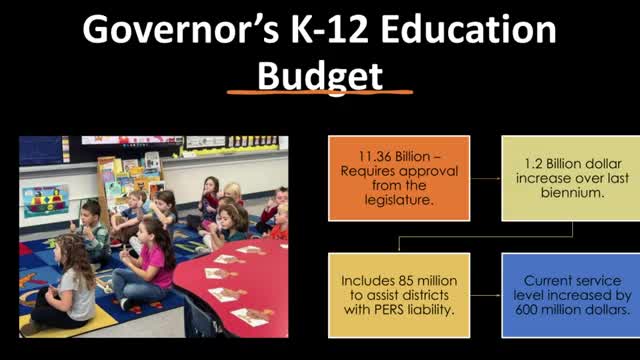Governor proposes $11.36B education budget amid rising PERS liabilities
December 09, 2024 | Silver Falls SD 4J, School Districts, Oregon
This article was created by AI summarizing key points discussed. AI makes mistakes, so for full details and context, please refer to the video of the full meeting. Please report any errors so we can fix them. Report an error »

The recent School Board meeting on December 9, 2024, highlighted a significant budget proposal from the governor, which could reshape K-12 education funding in Oregon. The proposed budget stands at an impressive $11.36 billion, marking a $1.2 billion increase from the previous biennium. This budget requires legislative approval and is expected to spark extensive advocacy efforts from various educational organizations.
Key discussions centered around the implications of this budget for local districts, particularly concerning the Public Employees Retirement System (PERS) liabilities. The governor's budget allocates approximately $85 million to assist districts with these liabilities, but many officials expressed concerns that this amount may not be sufficient for larger districts facing substantial financial pressures.
The board emphasized the urgency of addressing long-term facilities issues, such as the leaking roof at Mark Twain School, which underscores the need for proactive planning in maintenance and upgrades. With the current funding levels, officials worry that they lack the necessary cushion to tackle these pressing infrastructure needs.
While the proposed budget represents the highest increase in current service levels seen in decades, board members cautioned that inflation and rising staffing costs may dilute its impact. They noted that the increase, spread over two years, equates to only a 5% annual rise, which may not adequately support the growing demands on school districts.
The meeting also touched on the need for further advocacy regarding special education funding, with hopes to increase reimbursement rates for high-cost disabilities. Despite the positive steps represented by the governor's proposal, officials acknowledged that more work is needed to ensure that all students receive the support they require.
As the legislative session approaches, the board is gearing up for a proactive approach to secure additional funding and address the pressing needs of their districts. The outcome of these efforts will be crucial in determining the future of education funding in Oregon.
Key discussions centered around the implications of this budget for local districts, particularly concerning the Public Employees Retirement System (PERS) liabilities. The governor's budget allocates approximately $85 million to assist districts with these liabilities, but many officials expressed concerns that this amount may not be sufficient for larger districts facing substantial financial pressures.
The board emphasized the urgency of addressing long-term facilities issues, such as the leaking roof at Mark Twain School, which underscores the need for proactive planning in maintenance and upgrades. With the current funding levels, officials worry that they lack the necessary cushion to tackle these pressing infrastructure needs.
While the proposed budget represents the highest increase in current service levels seen in decades, board members cautioned that inflation and rising staffing costs may dilute its impact. They noted that the increase, spread over two years, equates to only a 5% annual rise, which may not adequately support the growing demands on school districts.
The meeting also touched on the need for further advocacy regarding special education funding, with hopes to increase reimbursement rates for high-cost disabilities. Despite the positive steps represented by the governor's proposal, officials acknowledged that more work is needed to ensure that all students receive the support they require.
As the legislative session approaches, the board is gearing up for a proactive approach to secure additional funding and address the pressing needs of their districts. The outcome of these efforts will be crucial in determining the future of education funding in Oregon.
View full meeting
This article is based on a recent meeting—watch the full video and explore the complete transcript for deeper insights into the discussion.
View full meeting
